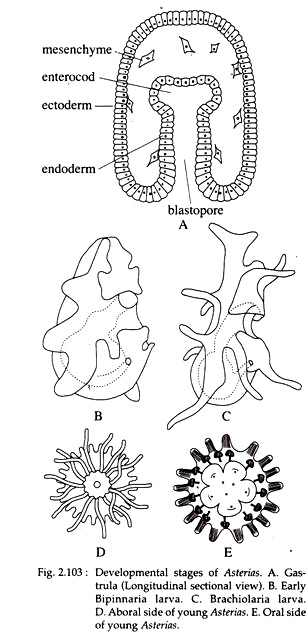In this article we will discuss about the Metamorphosis in Star Fish:- 1. Introduction to Metamorphosis in Star Fish 2. Course of Metamorphosis in Star Fish 3. Role of Hormone.
Introduction to Metamorphosis in Star Fish:
In star fish fertilization is external i.e., eggs and sperms are released in the sea water where fertilization occurs. The fertilized eggs are spherical and yolky. This egg i.e., zygote, undergoes total cleavage and through blastula stage reaches an oval gastrula stage.
Initially the outer cells of the gastrula are ciliated. Gradually, the gastrula elongates and the cilia over the surface of the body become restricted along definite bands. This gastrula is transformed into a larva which in course of time metamorphoses into an adult starfish.
Course of Metamorphosis in Star Fish:
The shape of the larva gradually changes. With the elongation of body, the blastopore, at the middle of the two poles, becomes subsequently shifted to the posterior end. The outer layer is converted into ectoderm. The space between the ectoderm and the endoderm becomes occupied by the mesenchyme (Fig. 2.103A).
The cavity of the gastrula becomes distinguishable into two parts, the archenteron and the enterocoel. The narrower proximal part is called the archenteron and the wider terminal part is called the enterocoel. The blastopore becomes the larval anus.
The enterocoel gives off right and left lateral pouches called the enterocoelic pouches. The enterocoel becomes completely closed off from the gut and becomes divided into three parts, an anterior part and two lateral (right and left) parts in the form of pouches.
The left pouch grows faster than the right and proceeds posteriorly in the space between the body wall and the alimentary canal. The anterior undivided portion becomes subsequently cut off from the lateral pouches and forms the coelom of the preoral lobe. This part gives off a five-lobed extension on the left called hydrocoel. From the hydrocoel the entire adult ambulacral system develops.
Two apertures appear on the surface—one is the mouth on the ventral side and the other on the dorsal side called the dorsal pore. The mouth opens into the larval stomach and the larval anus soon closes. The particular type of larva in star fishes is called Bipinnaria larva (Fig. 2.103B). It has bilaterally symmetrical lobes with ciliated bands. The Bipinnaria larva is succeeded by Brachiolaria stage (Fig. 2.103C).
ADVERTISEMENTS:
The preoral lobe of the larva assumes an elongated cylindrical larval organ. An elevation, the rudiment of sucker develops at the middle of the larval organ. The sucker helps in the attachment of the larva during metamorphosis.
The larva is transformed into the five-rayed starfish by the elimination of the preoral lobe, by the development of the arms and tube-feet and by changing the internal structures. The larval mouth disappears and a new mouth is formed at the centre of the hydrocoel. The permanent anus is formed on the dorsal side.
Role of Hormone in Star Fish:
The general concept is that wherever there is cephalization and centralization of the nervous system, neurosecretory cell groups can be found in invertebrates. Among the echinoderm with their radial nervous system, neurosecretory cells have not been revealed as yet. Therefore, no substantial data on the action of hormone during the metamorphosis can be presented.
